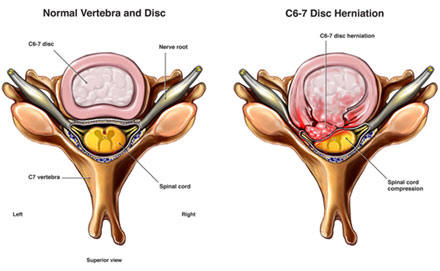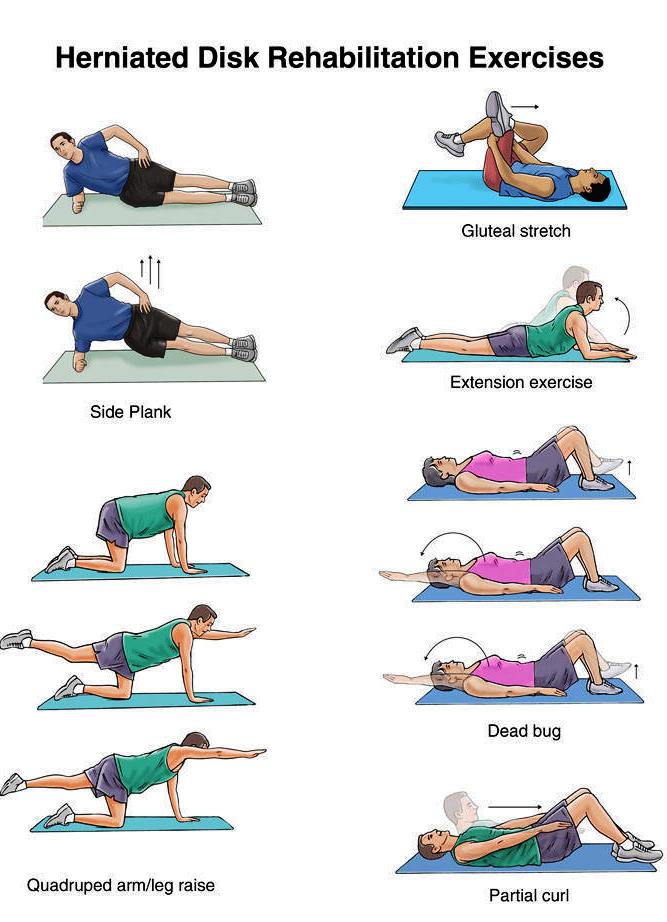|
|




 |
|
BACK &
NECK PAIN:
The lower
back is an intricate structure of interconnected and
overlapping elements:
-
Tendons and muscles
and other soft tissues
-
Highly sensitive
nerves and nerve roots that travel from the lower back
down into the legs and feet
-
Small and complex
joints
-
Spinal discs with
their gelatinous inner cores.
An
irritation or problem with any of these structures can cause
lower back pain and/or pain that radiates or is referred to
other parts of the body. Pain from resultant lower back
muscle spasms can be severe, and pain from a number of
syndromes can become chronic.
While lower back pain is extremely common,
the symptoms and severity of lower back pain vary greatly. A
simple lower
back muscle strain might
be excruciating enough to necessitate an emergency room
visit, while adegenerating
disc might
cause only mild, intermittent discomfort.
Identifying the symptoms, along with an accurate diagnosis
of the underlying cause of the pain, is the first step in
obtaining effective pain relief.
Lower
Back Pain Causes by Age
Certain
causes of lower back pain have a tendency to occur more
often in younger individuals versus older adults:
These lower back pain symptoms include any
combination of the following:
-
Difficulty
moving that can be severe enough to prevent walking or
standing
-
Pain that
does not radiate down the leg or pain that also moves
around to the groin, buttock or upper thigh, but rarely
travels below the knee;
-
Pain that
tends to be achy and dull
-
Muscle
spasms, which can be severe
-
Local
soreness upon touch
Possible causes:
1- Back Muscle Strain
A back muscle strain or ligament strain is
one of the most common causes of acute lower back pain.
Lifting a heavy object, twisting, or a sudden movement can
cause muscles or ligaments stretch or develop microscopic
tears.
With a lower back strain, the severity of the
pain ranges from mild discomfort to severe, disabling pain,
depending on the extent of strain and the lower back muscle
spasms that result from the injury.
Back strains often heal on their own with the
help of some combination or rest, ice and/or heat
application, anti-inflammatory medications, and/or gradual
and gentle stretching and lower back exercises.
2- Low back pain that travels to the buttock,
leg and foot (sciatica)
Sciatica includes any combination of the
following symptoms:
-
Pain
typically is ongoing (as opposed to flaring up for a few
days or weeks and then subsiding)
-
Pain may
be worse in the leg and foot than in the lower back
-
Typically
felt on one side the buttock or leg only
-
Pain that
is usually worse after long periods of standing still or
sitting: relieved somewhat when walking
-
More
severe (burning, tingling) vs. dull, aching pain
-
May be
accompanied by weakness, numbness or difficulty moving
the leg or foot
Frequent cause of sciatica:
Lumbar herniated disc

Sciatica
describes the symptoms caused when a nerve root in the lower
spine is compressed, causing pain and numbness to travel
along the large sciatic nerve that serves the buttocks, legs
and feet.
In younger
adults, sciatica can be caused by a wide range of
conditions, most commonly a lumbar herniated disc (may also
be caused by degenerative disc disease, isthmic
spondylolisthesis, and other conditions).
Symptoms:
Deep ache in the lower back that worsens when standing or
walking
Symptoms may
include any combination of the following:
-
Pain that
radiates into the buttocks and back of the thighs (also
called sciatica or radicular pain)
-
Pain that
worsens when bending backwards
-
Pain that
feels better with sitting, especially sitting in a
reclining position
-
Tired
feeling in the legs, and possibly leg numbness or
tingling, especially after walking
-
Tight
hamstrings, making it difficult to touch toes
This is more common with older
patients and is often related to canal stenosis and also
called claudication.
Possible cause: Isthmic
spondylolisthesis
Isthmic
spondylolisthesis occurs when a vertebra in the low back
slips forward on the disc space below it. It is most common
at the L5-S1 level and can cause low back pain from
instability and nerve root pain due to compression of the
nerve root.The fracture occurs in childhood, but normally
does not create a lot of pain until a patient is in young
adulthood.Symptoms include pain on bending or changing
postures, may be associated with pain radiating to leg or
buttocks.
When to Seek Immediate Treatment for Lower
Back Pain
Most cases of low back pain do not require
urgent care, but patients should seek a doctor immediately
if they experience low back pain as a result of severe
trauma, or if low back pain is accompanied by any of the
following:
-
Fever and chills
-
Unexplained recent weight loss, or recent
weight loss due to trauma
-
Significant leg weakness
-
Sudden bowel and/or bladder incontinence
- either difficulty passing urine or having a bowel
movement, or loss of control of urination or bowel
movement (cauda
equina syndrome)
-
Severe, continuous abdominal pain (abdominal
aortic aneurysm)
Daignostic tests
When pain is severe and is not relieved
within 6 to 12 weeks, a specific diagnosis becomes more
important to determine further treatment. Additional
diagnostic tools include:
-
X-ray.
Provides information on the bones in the spine; used to
test for spinal instability, tumors and fractures.
-
CT scan.
Captures cross-section images of the vertebrae and
spinal discs; can be used to check for herniated disc or
spinal stenosis.
-
Myelogram.
Allows identification of problems within the spine,
spinal cord and nerve roots. An injection of contrast
dye illuminates the spine prior to an x-ray or CT scan.
-
MRI scan.
Displays detailed cross-section of the components of the
spine. Useful to assess issues with lumbar discs and
nerve roots, as well as ruling out causes of lower back
pain like spinal infections or tumors.
Treatment
Treatment for lower back pain depends upon
the patient's history and the type and severity of pain. The
vast majority of lower back pain cases get better within six
weeks without surgery, and lower back pain exercises are
almost always part of a treatment plan.
If pain persists or worsens, more involved
diagnostic and surgical procedures may be recommended.
-
Rest.
Ceasing activity for a few days allows injured tissue
and even nerve roots to begin to heal, which in turn
will help relieve lower back pain. However, more than a
few days of rest can lead to a weakening of the muscles,
and weak muscles have to struggle to adequately support
the spine. Patients who do not regularly exercise to
build strength and flexibility are more likely to
experience recurrent or prolonged lower back pain.
-
Heat and Ice Packs help
relieve most types of low back pain by reducing
inflammation. Often patients use ice, but some prefer
heat. Both may be used alternately.
-
Medications.
A wide variety of over-the-counter and prescription
medications is available to help reduce symptoms of
lower back pain. Many medications reduce inflammation,
which is often a cause of pain, while others work to
inhibit the transmission of pain signals from reaching
the brain. Each medication has multiple unique risks,
possible side effects and drug (or food or supplement)
interactions, which need to be evaluated by a physician.
-
Exercise for Lower Back Pain.
Exercise is a key element of almost any lower back pain
treatment plan. Whether completed at home, or with a
spine health professional, such as a physical therapist,
chiropractor, or physiatrist, a plan will typically
include three components: aerobic conditioning,
stretching, and strengthening. The exercises are best
done through a controlled, progressive program, with the
goal of building toward a stronger, more flexible spine.
-
Low Impact Aerobic Exercise.
In addition to exercises specific to the lower back, any
low impact aerobic exercise, such as walking, is often
an ideal exercise for the lower back because it helps
bring oxygen to the soft tissues in the back to promote
healing. Swimming or water exercise has the same effect
and is an excellent option if walking is too painful.
-
Chiropractic Adjustment (also called
Chiropractic Manipulation)can
help improve spinal function by decreasing pain and
inflammation to increase range of motion and physical
function.
-
Epidural Steroid Injections deliver
steroids directly into the painful area of the lower
back to reduce inflammation. The steroids do not heal
the components of the back, but often provide enough
pain relief to allow patients to move, exercise and
heal.- AT OUR CENTRE IT IS DONE BY PAIN EXPERTS. IT IS A
DAY CARE PAINLESS PROCEDURE..
-
Surgery for Lower Back Pain is
usually considered after pain has not been relieved with
nonsurgical methods. Still, surgery is always the
patient’s decision, and a qualified spine surgeon will
be able to explain the pros and cons of each procedure.
For sciatica, laminectomy andmicrodiscectomy have
been shown to significantly reduce pain symptoms by
relieving the pressure on compressed nerve roots.
-
Fusion surgery,
which is used to stop the motion at a motion segment, is
a bigger surgery but can be effective at relieving pain
due to a painful motion segment.
SPINAL SURGERIES ARE DONE BY EXPERTS BY THE
LATEST MOST ADVANCED TECHNIQUES AT OUR CENTRE TO ENSURE FAST
REHABILITATION AND ACTIVITY BACK TO NORMAL.
EXERSIES-
CAUTION DO NOT PERFORM THESE
EXERCISES UNLESS ADVISED/SUPERVISED BY AN EXPERT

|
|